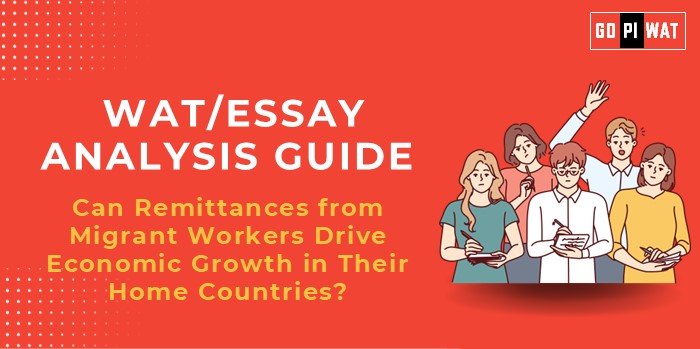📋 Written Ability Test (WAT) Analysis Guide
🌍 Topic: Can Remittances from Migrant Workers Drive Economic Growth in Their Home Countries?
🌐 Understanding the Topic’s Importance
Remittances are essential for socioeconomic stability, helping millions in developing nations meet their basic needs. For B-school students, understanding their role connects to themes of financial inclusion, policy innovation, and global economic integration.
⏳ Effective Planning and Writing
- Time Allocation:
- Planning: 5 minutes
- Writing: 20 minutes
- Review: 5 minutes
- Preparation Tips:
- Identify statistics on remittance flows.
- Note key stakeholders and developmental impacts.
✍️ Introduction Techniques for Essays
- Contrast Approach: “While remittances lift millions out of poverty, they can create overdependence, hindering economic diversification.”
- Solution-Based Approach: “Reducing global remittance transfer fees from 6.3% to the SDG target of 3% could free up billions for development.”
📊 Structuring the Essay Body
- Achievements:
- Cite data on poverty reduction and household spending.
- Challenges with Comparative Analysis:
- Discuss high fees and overdependence risks using global examples.
- Future Outlook:
- Highlight technological innovations and policy recommendations.
📄 Concluding Effectively
- Balanced Approach: “Remittances offer immense potential, but strategic policies are needed to mitigate risks and maximize developmental impacts.”
- Global Comparison Approach: “Countries like the Philippines and Bangladesh demonstrate how structured remittance policies can amplify economic benefits.”
🚀 Recommendations for Sustainable Progress
- Reduce transfer costs.
- Encourage diaspora investments.
- Strengthen formal remittance channels.
📝 Sample Short Essays
- Balanced Perspective: “Remittances are a double-edged sword: a lifeline for millions yet a crutch for economies over-reliant on external inflows.”
- Solution-Oriented: “Technological advances in remittance services can reduce costs, boosting funds for education and business investments in developing nations.”
- Global Comparison: “With remittance inflows exceeding FDI in many countries, strategies like Bangladesh’s microfinance integration model must be emulated globally.”


